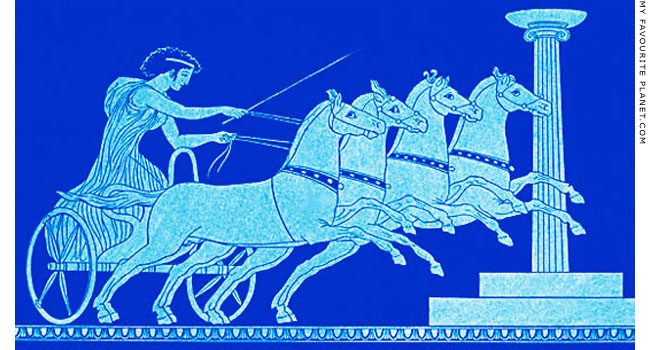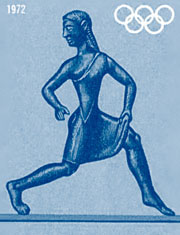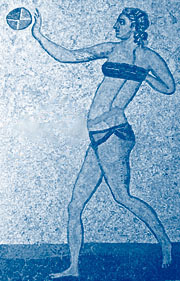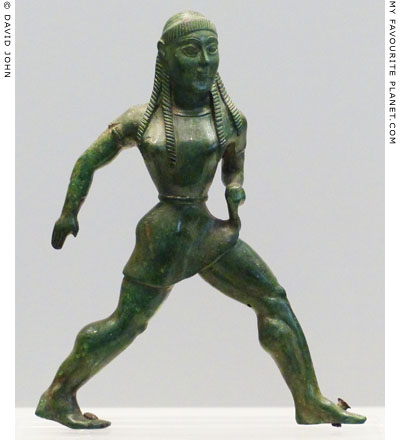|
|
 |
| My Favourite Planet > Blogs > Edwin Drood's Column > June 2011 |
 |
 |
back |
Edwin Drood's Column |
 |
28 June 2011 |
 |
| |
 |
 |
| Blend it like Beckham |
In which Edwin considers the Tomboy gene and wonders
whether we would not all benefit from a bit of hard play.
|
My cousin Fiona’s eldest, Beth, is what used to be called a “tomboy” but now gets tagged as a role model. It was to be expected that the Pankhurst blood would sooner or later produce a Diana or an Athena, and Beth is the real deal: looks like a goddess, moves like an angel, and hurts like a West End bouncer with the gloves off.
First it was horses, like most girls, but they weren’t near scary enough for Beth without some added value, so she “negotiated” an adventure holiday for her fifteenth birthday, learning rodeo tricks and steer-roping. Beth was a sweet-natured, quiet girl at the time, without any of the usual tendencies toward door slamming or sulking in the bathroom, so it rather took the family by surprise when she came back from her summer camp in Texas and immediately got her elder brother to strip his bicycle of all non-essentials (like brakes?) and turn it into a downhill racer.
Halfway into her A-level year, Beth wrecked her third, and seriously expensive, carbon-fibre mount while hurtling through some vertical underbrush in Scotland. The collar-bone was bad enough, the elbow was worse, and the punctured spleen was very nasty indeed. Fortunately, what was initially thought to be a multiple spinal torsion fracture turned out to be severe contusion. Nevertheless, the accident (or suicide attempt, depending on your position), cost her a potential place on the English team and a whole year of school. But Beth came back to waltz through a quartet of sciences sufficiently well to get into one of the better red-bricks and reinvent herself as a soccer player. In the late nineties she could be found on the bedroom walls of aspiring Beckhamettes and their boy and/or girlfriends, looking charmingly disarrayed and damp, wrapped in nothing more than a team towel and balancing a ball on one finger for verisimilitude. These days she’s a science and sports teacher who successfully coaches both boys and girls teams at a big North London comprehensive. |
| German girls rule |
| |
 |
Why am I telling you this? Because the female soccer World Cup is getting into gear and the favourites, Germany of course, will take home 60,000 € per player in bonus money if they win yet again. Yes, girl-sports are big money now and getting bigger. One of the prime reasons is that women, being ever so slightly slower and less physically strong than men, are forced to play with more strategy, so the game stays interesting and has a better flow to it. If it weren’t for the occasional artist like Stefan Edberg, men’s tennis would be a bleak catalogue of slammers. There is far more style in the female game and this contributes to its popularity.
But it’s not just about what happens on the field, track or court. Women athletes are generally easier on the eye and thus more commercially interesting than men, so the sums they make on sponsorship and publicity are rising steadily. Naturally there is a danger. Beautiful, curvy players may do for women’s soccer and other sports, what Anna Kournikova did for women’s tennis: nearly derail it by taking our eyes off the ball and diminish its “seriousness”, so there won’t be any repeats of the German soccer girls stripping down for Playboy. Agents, managers and the sport’s official body are becoming stricter about handling its image. However, even here it becomes essentially a question of gender equality. After all, if the men are allowed to get sweaty for magazine and calendar shots, why not the women? |
| Rappelling down Oxford Street |
Tomboy behaviour is under-researched. Why some girls (and not just the chunky ones) want to get dangerously close to nature, close to the edge of their safety zone, close to their physical limits is still a mystery. Certainly the adventurous girl is more likely to ensnare the adventurous man, and it may be very good for the gene pool. Extreme shopping used to suffice for the Becky Sharps of this world. But there are other girls who are more likely to be found halfway down a cliff than halfway up Oxford Street. And since many of them choose solitary sports, while others are in strictly girls’ leagues, their opportunities for meeting the “right” bloke are not necessarily improved. So if it’s not about testosterone or pheromones, what is it about? |
| Careering up the fast lane |
| |
 |
The answer may be blindingly simple. Perhaps the proportion of girls who would like to live in the fast lane is identical to the proportion of boys; they simply express this desire in a less assertive manner, so it sometimes goes unnoticed. We are an adventurous, even reckless species, nature’s natural risk-takers, forever trying to prove ourselves capable, even exceptional, on several fronts at once. And quite possibly we do it for our own personal satisfaction rather than for any evolutionary advantage. It’s just play, and some play harder than others, that’s all. Yet we are increasingly moulded into a safety-first, career first, family first, studies first, full-body brace. These are evolutionary constraints, too, but different ones.
Each of us is such a complex blend of characteristics and drives; it’s hard to say, at the outset, which flavour will dominate and for how long. The risk-taker will eventually settle down to a normal life. The normal guy or girl may suddenly go berserk at 40 and buy a Harley or go down in flames with his/her secretary or physiotherapist. Playing hard is a good way to get all that out of our system early, as well as being a good way to ensure that equality is deeply anchored and basically taken for granted. Miss Gradenko, are you safe? Probably not ... and maybe it’s better that way.
© Edwin Drood, June 2011 |
|
| |

Bronze figurine of a female runner, probably a Spartan athlete
taking part in the Heraia (Ἡραῖα, in honour of Hera), foot
races for girls or unmarried young women held at Olympia.
From the decoration from the rim or shoulder of a krater
(mixing vase) or cauldron. Laconian workshop, 550-540 BC.
Found in 1875 in the Sanctuary of Zeus at Dodona, near
Ionnina, northwestern Greece, during excavations by
Konstantinos Karapanos (see note in Homer part 3).
National Archaeological Museum, Athens. Inv. No. Kar. 24.
From the Konstantinos Karapanos Collection. |
Edwin Drood's Column, the blog by The Mysterious Edwin Drood,

at My Favourite Planet Blogs.
We welcome all considerate responses to this article
and all other blogs on My Favourite Planet.
Please get in contact. |
 |
Visit the My Favourite Planet Group on Facebook.

Join the group, write a message or comment,
post photos and videos, start a discussion... |
|
Views of blog authors do not necessarily reflect those of the publishers
or anyone else at, on or in the vicinity of My Favourite Planet. |
 |
 |
|
|
| |
| |
|
| |
 |
| |
 |
| |
 |
| |

George Alvanos

rooms
in Kavala's historic Panagia District

Anthemiou 35,
Kavala, Greece

kavalarooms.gr
 |
| |

Olive Garden Restaurant

Kastellorizo, Greece

+30 22460 49 109

kastellorizo.de
 |
| |

Papoutsis
Travel Agency

Kastellorizo, Greece

+30 22460 49 286

greeklodgings.gr
 |
| |
|